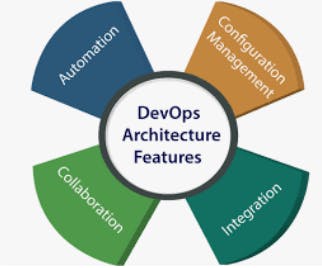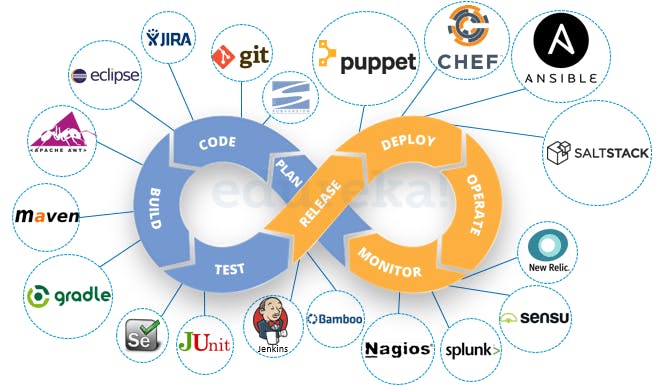#Devops #TrainWithShubham
What is DevOps?
DevOps is a combination of two words, one is Software Development, and the second is Operations. This allows a single team to handle the entire application lifecycle, from development to testing, deployment, and operations.

DevOps promotes collaboration between Development and Operations teams to deploy code to production faster in an automated & repeatable way.
DevOps helps to increase organization speed to deliver applications and services. It also allows organizations to serve their customers better and compete more strongly in the market.
DevOps is nothing but a practice or methodology of making "Developers" and "Operations" folks work together. DevOps represents a change in the IT culture with a complete focus on rapid IT service delivery through the adoption of agile practices in the context of a system-oriented approach.
Organizations that implement DevOps correctly and put a unified delivery ecosystem in place can expect the following benefits:
Continuous monitoring of applications and infrastructure
Higher overall productivity
Deployment Automation
Automated Testing workflows
Faster delivery
Automated Code Coverage workflows
Security
Cross-functional teams
Improved quality (due to a reliable delivery ecosystem)
Lower costs (through streamlined delivery)
Transparent communication
Continuous feedback
Faster resolution of issues
Some of the key features of DevOps architecture:

Automation - Automation helps to reduce time during the testing and deployment phase. With automation, productivity increases, and releases are made faster. This helps in catching bugs quickly so that they can be fixed easily. For continuous delivery, each code drop is defined through automated tests, cloud-based services, and builds. The builds are deployed in production using automation, to reduce human errors caused due to manual deployment.
Collaboration - DevOps is a collaboration of the Development and Operations team. It improves the working model of the teams and they become more productive with their productivity, which strengthens accountability and ownership. The teams work in close collaboration sharing responsibilities, which in turn makes the deployment to production faster.
Integration - Software Applications need to be integrated with other components in the environment. The integration phase is where the existing code is combined/merged with new features/functionality and then tested. Continuous integration and testing enable continuous development. A significant operational challenge is faced in how frequently the releases are to be made. To cater to such problems, continuous integration and delivery are implemented. It ensures quicker, safer, and reliable deliveries.
Configuration management - Configuration management helps in building robust and stable systems for the engineering teams using tools that can automatically manage and monitor updates to the configuration data. The configuration file can be written during deployment(for the automated environment), or it can be loaded at the run time(manually), depending on the environment in which it is running.
What is DevOps Lifecycle?
DevOps Lifecycle is a methodology software development teams use to bring products to market more quickly and efficiently. It's a way of managing the entire software lifecycle from development through release, focusing on collaboration between developers and IT operations professionals. Constant software creation, development, verification, release, and management are part of the DevOps lifecycle.

Let's take a quick look at how the DevOps lifecycle functions at each step:
Plan - Professionals determine the commercial need and gather end-user opinions throughout this level. In this step, they design a project plan to optimize business impact and produce the intended result.
Code - During this point, the code is being developed. To simplify the design process, the developer team employ lifecycle DevOps tools and extensions like Git that assist them in preventing safety problems and bad coding standards.
Build - After programmers have completed their task, they use tools such as Maven and Gradle to submit the code to the common code source.
Test - To assure software integrity, the product is first delivered to the test platform to execute various sorts of screening such as user acceptability testing, safety testing, integration checking, speed testing, and so on, utilizing tools such as JUnit, Selenium, etc.
Release - At this point, the build is prepared to be deployed in the operational environment. The DevOps department prepares updates or sends several versions to production when the build satisfies all checks based on the organizational demands.
Deploy - At this point, Infrastructure-as-Code assists in creating the operational infrastructure and subsequently publishes the build using various DevOps lifecycle tools.
Operate - This version is now convenient for users to utilize. With tools including Chef, the management department take care of server configuration and deployment at this point.
Monitor - The DevOps workflow is observed at this level depending on data gathered from consumer behavior, application efficiency, and other sources. The ability to observe the complete surroundings aids teams in identifying bottlenecks affecting the production and operations teams' performance.
Conclusion
Today, the DevOps lifecycle is being implemented in more organizations to optimize the entire software development process. The main focus of DevOps is on collaboration between the developers and the operations team to ensure speed and collaboration as well as meeting customer requirements. It takes many steps for a software product to go from initial idea to market to enable collaboration across teams and companies.The major goal of the DevOps application lifecycle management is to keep things running smoothly and maximize efficiency. This all comes down to how well the programmers, testers, and operational groups work together to provide a high-quality software product with a better user interface.
Thanks For Reading
Paramveer Singh
